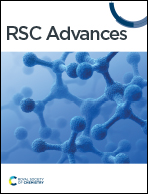Solvent and catalyst free vitrimeric poly(ionic liquid) electrolytes†
Abstract
Polymer electrolytes (PEs) are a promising alternative to overcome shortcomings of conventional lithium ion batteries (LiBs) and make them safer for users. Introduction of self-healing features in PEs additionally leads to prolonged life-time of LIBs, thus tackling cost and environmental issues. We here present solvent free, self-healable, reprocessable, thermally stable, conductive poly(ionic liquid) (PIL) consisting of pyrrolidinium-based repeating units. PEO-functionalized styrene was used as a co-monomer for improving mechanical properties and introducing pendant OH groups in the polymer backbone to act as a transient crosslinking site for boric acid, leading to the formation of dynamic boronic ester bonds, thus forming a vitrimeric material. Dynamic boronic ester linkages allow reprocessing (at 40 °C), reshaping and self-healing ability of PEs. A series of vitrimeric PILs by varying both monomers ratio and lithium salt (LiTFSI) content was synthesized and characterized. The conductivity reached 10−5 S cm−1 at 50 °C in the optimized composition. Moreover, the PILs rheological properties fit the required melt flow behavior (above 120 °C) for 3D printing via fused deposition modeling (FDM), offering the possibility to design batteries with more complex and diverse architectures.



 Please wait while we load your content...
Please wait while we load your content...